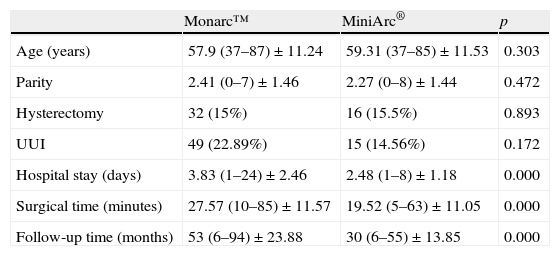The treatment of female stress urinary incontinence has undergone a revolution in recent years due the emergence on the market of suburethral slings. The aim of this study is to compare two surgical techniques for treating stress urinary incontinence: Monarc™ (transobturator suburethral sling) and MiniArc® (single-incision suburethral mini-sling).
Materials and methodsComparative, retrospective, observational study from January 2005 to December 2011 on 317 women diagnosed with stress urinary incontinence. Of these, 214 were treated with the Monarc™ transobturator suburethral sling, and 103 were treated with the MiniArc® mini-sling. The results were treated with SPSS v.15 software, and the statistical significance was p≤.005.
ResultsThe two patients groups were homogeneous in terms of age, number of births, presence of urgency urinary incontinence and prior hysterectomy. There were significant differences in hospital stay, surgical time and early complications in favor of the MiniArc®, technique, but overall there were no significant differences in the late complications. Some 84% of the patients treated with the Monarc™ transobturator sling were cured compared with the 72% of patients in whom we implanted a MiniArc®, a difference that was statistically significant.
ConclusionWe need to perform more high-quality, prospective and randomized studies with larger number of patients and longer follow-up times to confirm or disprove the difference that we found in the success rate for the Monarc™ transobturator suburethral sling.
El tratamiento de la incontinencia urinaria femenina ha sufrido una revolución en los últimos años por la aparición en el mercado de las cintillas suburetrales. El objetivo de este estudio es comparar 2 técnicas quirúrgicas para el tratamiento de la incontinencia urinaria de esfuerzo: Monarc™ (cintilla suburetral transobturadora) y MiniArc® (mini-cintilla suburetral de incisión única).
Material y métodosEstudio retrospectivo observacional comparativo desde enero de 2005 hasta diciembre de 2011 con 317 mujeres diagnosticadas de incontinencia urinaria de esfuerzo. Doscientas catorce fueron tratadas con la cintilla suburetral transobturadora Monarc™ y 103 con la mini-cintilla MiniArc®. Los resultados han sido tratados con el programa informático SPSS v 15 y el nivel de significación estadística ha sido p≤0.005.
ResultadosLos 2 grupos de pacientes son homogéneos en cuanto a la edad, el número de partos, la presencia de incontinencia urinaria de urgencia o histerectomía previa. Diferencias significativas en estancia hospitalaria, tiempo quirúrgico y complicaciones precoces a favor del Miniarc®, pero no en las tardías donde no hay diferencias significativas globales. El 84% de las pacientes tratadas con la cintilla transobturadora Monarc™ están curadas frente al 72% en las que colocamos un MiniArc® con diferencia significativa.
ConclusiónDebemos realizar un mayor número de estudios de alta calidad de carácter prospectivo y aleatorizados, con mayor número de pacientes y tiempo de seguimiento para confirmar o rechazar la diferencia que hemos encontrado en la tasa de éxito a favor de cintilla suburetral transobturador Monarc™.
Artículo
Comprando el artículo el PDF del mismo podrá ser descargado
Precio 19,34 €
Comprar ahora








